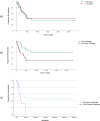Treatment Durability of Injection Augmentation of Vocal Fold Atrophy
- PMID: 40771842
- PMCID: PMC12326623
- DOI: 10.1002/lio2.70223
Treatment Durability of Injection Augmentation of Vocal Fold Atrophy
Abstract
Objective: Injection augmentation (or injection laryngoplasty) is a common treatment for presbyphonia. As current injection materials are temporary, it is anticipated that patients injected for presbyphonia will either need a repeat injection or framework surgery to maintain glottal competence (or sufficient glottal closure). Despite the expected temporary nature of these injections, patients report variable durability of effect, and some do not require a repeat injection. The primary aim of this investigation was to identify factors that affect treatment durability of injection augmentation among patients with presbyphonia.
Methods: Patients who underwent one or multiple injection augmentations for presbyphonia between May 2008 and September 2017 were extracted from the UW Madison Voice and Swallow Outcomes Database. Variables collected included demographics (age, sex), injection material, volume, duration between injections, date of first and last follow-up, voice therapy (yes/no, number of sessions), and pre- and post-injection voice measures (Maximum Phonation Time, Dysphonia Severity Index, Glottal Function Index score, Vocal Handicap Index Score) in an observational cohort design. For patients receiving one injection (TF group), duration between injection and last follow-up was taken as a durability measure termed "time to follow up." For patients receiving multiple injections (TR group), duration between injection treatments were termed "time to reinjection." Patients receiving one or more injections were compared separately and together (where treatment durabilityTF+TR refers to the combined TF + TR group) in different statistical analyses.
Results: Thirty-five patients with presbyphonia met inclusion criteria (mean age 74.3 years [SD 7.6], 78% male). Twenty patients received only one injection. Repeat injection augmentation was performed in 40% of patients (n = 15, ranging from 1 to 6 additional injection augmentations). Maximum phonation time increased after injection augmentation (or injection laryngoplasty) and was similar across injection materials (HA (mean change (SD)): +6 s (3) [95% CI 0.1-0.8], CaHa: +4 s (2.8) [95% CI 0.2-0.7], p < 0.001). Treatment durabilityTF+TR was longer for hyaluronic acid injectables when compared to calcium hydroxyapatite injectables (1232 days [CI: 552-1911] vs. 257 days [168-345], χ 2(2) = 7.505, p = 0.023). Voice therapy extended treatment durability TF+TR for injection augmentation compared to no voice therapy (1388 [95% CI: 772-2003] vs. 277 days [206-349 days], χ 2(1) = 9.173, p = 0.002). Age did not affect treatment durability TF+TR (χ 2 (1) = 1.01, p = 0.67).
Conclusion: Factors that affected treatment durability TF+TR for injection augmentation treatments were the type of injectable and whether patients underwent adjuvant voice therapy.
Level of evidence: III, Retrospective cohort study.
Keywords: dysphonia; glottal insufficiency; inadequate glottal closure; injection augmentation; injection laryngoplasty; injection material; presbyphonia; voice therapy.
© 2025 The Author(s). Laryngoscope Investigative Otolaryngology published by Wiley Periodicals LLC on behalf of The Triological Society.
Conflict of interest statement
The authors declare no conflicts of interest.
Figures
Similar articles
-
Injection laryngoplasty with hyaluronic acid for glottal insufficiency in unilateral vocal fold paralysis: a systematic review of the literature.Eur Arch Otorhinolaryngol. 2022 Nov;279(11):5071-5079. doi: 10.1007/s00405-022-07437-0. Epub 2022 Jun 29. Eur Arch Otorhinolaryngol. 2022. PMID: 35767054
-
A Systematic Review of Speech-Language Pathology Interventions for Presbyphonia Using the Rehabilitation Treatment Specification System.J Voice. 2024 Jan 8:S0892-1997(23)00396-X. doi: 10.1016/j.jvoice.2023.12.010. Online ahead of print. J Voice. 2024. PMID: 38195333 Free PMC article.
-
Short- and Longer-Term Effects of Three Intensive Straw Phonation Interventions on the Voice of Female Speech-Language Pathology Students With Mild Dysphonia: A Randomized Controlled Trial.Int J Lang Commun Disord. 2025 Jul-Aug;60(4):e70070. doi: 10.1111/1460-6984.70070. Int J Lang Commun Disord. 2025. PMID: 40622079 Clinical Trial.
-
Does Augmenting Irradiated Autografts With Free Vascularized Fibula Graft in Patients With Bone Loss From a Malignant Tumor Achieve Union, Function, and Complication Rate Comparably to Patients Without Bone Loss and Augmentation When Reconstructing Intercalary Resections in the Lower Extremity?Clin Orthop Relat Res. 2025 Jun 26. doi: 10.1097/CORR.0000000000003599. Online ahead of print. Clin Orthop Relat Res. 2025. PMID: 40569278
-
The Black Book of Psychotropic Dosing and Monitoring.Psychopharmacol Bull. 2024 Jul 8;54(3):8-59. Psychopharmacol Bull. 2024. PMID: 38993656 Free PMC article. Review.
References
LinkOut - more resources
Full Text Sources
Research Materials
Miscellaneous


